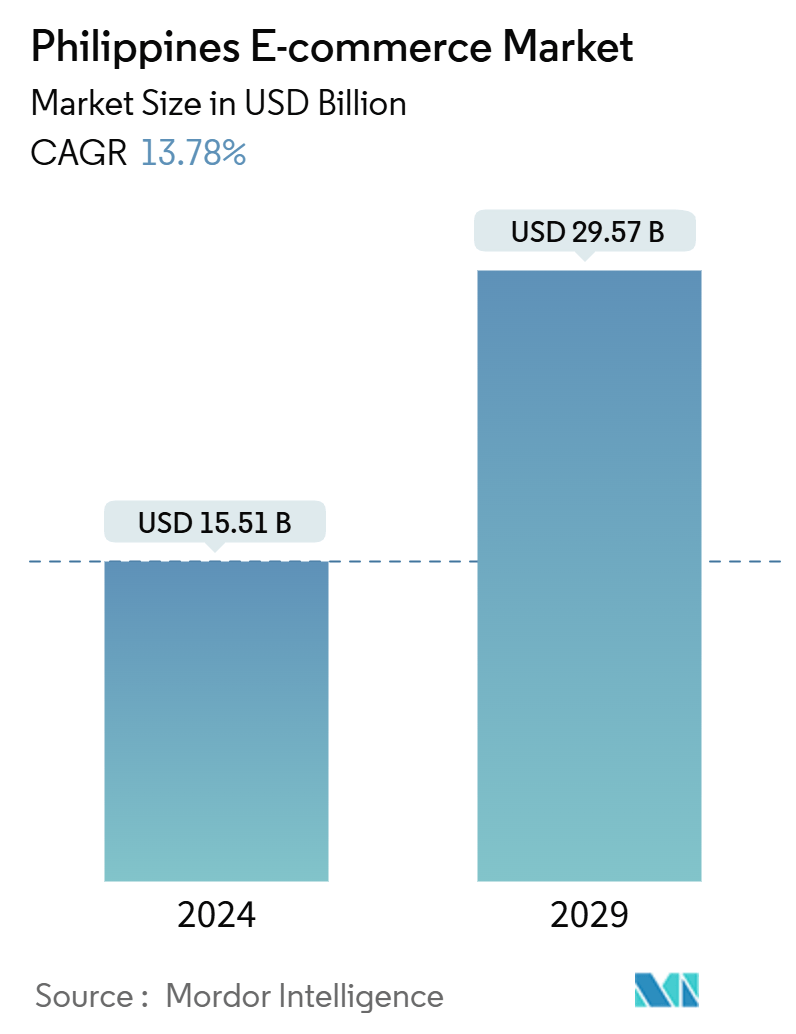Market Size of Philippines E-commerce Industry

| Study Period | 2019 - 2029 |
| Base Year For Estimation | 2023 |
| Market Size (2024) | USD 15.51 Billion |
| Market Size (2029) | USD 29.57 Billion |
| CAGR (2024 - 2029) | 13.78 % |
| Market Concentration | Medium |
Major Players
*Disclaimer: Major Players sorted in no particular order |
Philippines E-commerce Market Analysis
The Philippines E-commerce Market size is estimated at USD 15.51 billion in 2024, and is expected to reach USD 29.57 billion by 2029, at a CAGR of 13.78% during the forecast period (2024-2029).
Online purchasing and selling of products and services is known as e-commerce. Affiliate marketing strategies are also a possible part of the definition of an e-commerce firm. To increase online sales, users can leverage e-commerce platforms like their own website, through a well-known retailer like Amazon, or social media.
- Due to its strong economy and a significant number of digitally savvy people, the Philippines is one of Southeast Asia's fastest-growing e-commerce markets. Many websites and digital applications are striving for market share against local, regional, and global rivals. Owing to better connectivity in the Philippines and the developing infrastructure, a growing portion of the country's sizeable population is now connected to the Internet. The connected population of the Philippines typically accesses the nation's e-commerce market through computers and mobile devices.
- One of the biggest trends in online retail is platform convergence. Customers prefer an all-in-one shopping experience that includes product ratings and prices, buying, and making payments using the platforms' new online payment options. Consequently, online shopping features are available on portal websites, social media, TV home shopping, over-the-top media services (OTT), etc. As a result, their platforms are becoming more popular.
- The quick development of wireless and Internet technology has significantly impacted online retailing and e-commerce advancement. The accessibility of smart devices, advancements in telecommunications infrastructure, rising purchasing power, a lack of time, and additional convenience have compelled businesses to adopt technology and meet customers' expanding needs, which has sped up the development of this new business model for online food ordering.
- Despite its rapid progress, the Philippines has not yet made management and technology more accessible to wider audiences. E-commerce advancements have also been delayed by government officials and local organizations' inaction in defining infrastructure initiatives to promote the nation's technology and internet sectors. To accommodate the growing traffic in the area, carriers and governments in the nation need to make increases in internet speeds.
- A turning point for e-commerce in the Philippines was the COVID-19 pandemic, which resulted in lockdown and movement restrictions, drove demand to record highs, attracted new buyers and sellers to online marketplaces, and provided players with long-term development. The e-commerce industry benefited greatly from the epidemic as a result of containment efforts that made consumers aware of the convenience of online shopping and encouraged seasoned online shoppers to make additional purchases.
Philippines E-commerce Industry Segmentation
E-commerce is the buying and selling of goods and services over the Internet through online shopping. However, this term is often used to describe all the seller's efforts in selling products directly to consumers. It begins when potential customers learn about a product, buy it, use it, and ideally maintain lasting customer loyalty.
The scope of the study is limited to tracking the revenue generated through the e-commerce market in the Philippines. The study also tracks key market metrics, underlying growth influencers, and significant industry vendors, providing support for market estimates and growth rates in the Philippines e-commerce market throughout the anticipated period. The study looks at Covid-19's overall influence on the ecosystem. The report's scope includes market size and forecasting for B2B and B2C segments, with the qualitative analysis of the B2C channel being further split by application.
The Philippines e-commerce market is Segmented into B2C e-commerce (application (beauty and personal care, consumer electronics, fashion and apparel, food and beverage, furniture and home)) and B2B e-commerce. The market sizes and forecasts are provided in terms of value (USD) for all the above segments.
| By B2C E-commerce | ||||||||
| Market Size (GMV) for the Forecast Period | ||||||||
|
| By B2B E-commerce | |
| Market Size for the Forecast Period |
Philippines E-commerce Market Size Summary
The Philippines E-commerce market is experiencing rapid growth, driven by increasing consumer preference for online shopping and enhanced internet connectivity. The COVID-19 pandemic significantly accelerated this trend, prompting more businesses to leverage E-commerce platforms to reach a broader audience. The country's vibrant economy and tech-savvy population have positioned it as a burgeoning E-commerce hub in Southeast Asia. Despite challenges such as slow internet speeds and infrastructural issues, the market is expanding, with mobile devices playing a crucial role in accessing E-commerce services. The fashion industry, in particular, has seen substantial investments and international brand expansions, reflecting the growing demand for online shopping.
The E-commerce landscape in the Philippines is becoming increasingly competitive, with both local and international players vying for market share. Companies are focusing on enhancing delivery services and improving customer experiences through technological advancements like Augmented Reality. The market's growth is further supported by the rising middle class, high consumer spending, and the adoption of digital lifestyles. Initiatives by major E-commerce platforms to expand their reach and improve service offerings are contributing to the sector's development. As the market continues to evolve, it presents significant opportunities for businesses to tap into the growing digital economy in the Philippines.
Philippines E-commerce Market Size - Table of Contents
-
1. MARKET INSIGHTS
-
1.1 Market Overview
-
1.2 Industry Attractiveness-Porter's Five Forces Analysis
-
1.2.1 Bargaining Power of Suppliers
-
1.2.2 Bargaining Power of Buyers/Consumers
-
1.2.3 Threat of New Entrants
-
1.2.4 Threat of Substitute Products
-
1.2.5 Intensity of Competitive Rivalry
-
-
1.3 Key Market Trends and Share of E-commerce of Total Retail Sector
-
1.4 Impact of COVID-19 on the E-commerce Sales
-
-
2. MARKET SEGMENTATION
-
2.1 By B2C E-commerce
-
2.1.1 Market Size (GMV) for the Forecast Period
-
2.1.2 By Application
-
2.1.2.1 Beauty and Personal Care
-
2.1.2.2 Consumer Electronics
-
2.1.2.3 Fashion and Apparel
-
2.1.2.4 Food and Beverage
-
2.1.2.5 Furniture and Home
-
2.1.2.6 Others (Toys, DIY, Media, etc.)
-
-
-
2.2 By B2B E-commerce
-
2.2.1 Market Size for the Forecast Period
-
-
Philippines E-commerce Market Size FAQs
How big is the Philippines E-commerce Market?
The Philippines E-commerce Market size is expected to reach USD 15.51 billion in 2024 and grow at a CAGR of 13.78% to reach USD 29.57 billion by 2029.
What is the current Philippines E-commerce Market size?
In 2024, the Philippines E-commerce Market size is expected to reach USD 15.51 billion.

